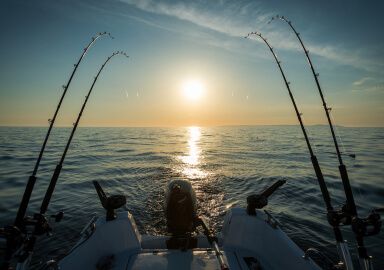Little Tunny (False Albacore)
Little tunny are small tunas that form dense shoals in the upper regions of the ocean and can provide excellent light tackle sport fishing opportunities.
View 9 listings
9
listings
–
price starting from
5
countries
–
to the nearest trip
Where and When?
Found in the more central waters of the Atlantic Ocean, little tunny are found between latitudes 56 degrees N. to 30 degrees S., which translates into Newfoundland, across to the United Kingdom and central Brazil to central Angola. They are also found throughout the Mediterranean Sea as well as the Black Sea. They are said to prefer the surface 200 meters of the water body known as the “neritic” water and are usually fairly close to shore. Unlike many other tunas, little tunny seem to be attracted to features such as headlands and harbours where their principal prey of small fish, like sardines, often congregate. Much of their feeding seems to take place near the surface and, as this is often near the shore, masses of diving birds can indicate the feeding of this species. Little tunny can be caught throughout the year, but, in the higher latitudes, the warmer months are best. There is discussion around their natural feeding times and, while much clearly takes place during daylight, as with most fishing, some authors suggest they also feed after dark, especially on moonlit nights.
About Little Tunny (False Albacore)
Little tunny, Euthynnus allettratus, are a typical looking “tuna shaped” member of the Scomberidae family that includes all mackerel, bonito and tunas. They are bright electric blue to green above, fading down the sides to a white belly. Along the back of the body are characteristic “curvy lined” darker markings, as well as 3-7 dark spots between the pectoral fins and the anal fin. They are carnivores with large eyes and a big mouth, rigid jaws and smallish strong teeth with which to catch the fish, crustaceans, tunicates and squid that form most of their prey. Being one of the smaller tunas, they can still attain 122 cm (48 in.) and 16.5 kilograms (36.4 lbs.) but a more common length is about 80 cm (31.5 in.). They grow rapidly, reach maturity at about three years and can live up to about 10 years. They are strongly migratory and head to the warmer waters in winter, southwards in the northern hemisphere and the opposite in the southern hemisphere. Little tunny are reported to have an extended spawning period of April to November, in northern waters and spend most of their time in large, dense shoals of similar-sized fish that can contain several other similar tuna species.
How to Catch?
While little tunny are not often a top target species for most big-game charters and operators, they can provide excellent fun, excitement and sport. Many anglers, especially in the eastern Atlantic Ocean, have developed an almost “cult following” of this species due to its numbers, high speeds and fighting ability. Little tunny have been recorded to reach the speed of 64 km/h (40 mph.) in short bursts and they are also well known for stamina and dogged fighting. Targeting feeding shoals of little tunny can also be an excellent and fun way of breaking a long spell of ‘no bites’ whilst fishing for marlin. The most popular fishing method is spinning, with light or medium equipment, using artificial lures and a fast and erratic recovery. This can be extremely exciting and productive, when casting into a “feeding” frenzy and can result in explosive action. In suitable areas, where there is deep water close to shore, fishing from headlands and cliffs is popular. While not often regarded as a top tasting fish, little tunny are a species that ranks high in terms of sport, excitement and fun.





